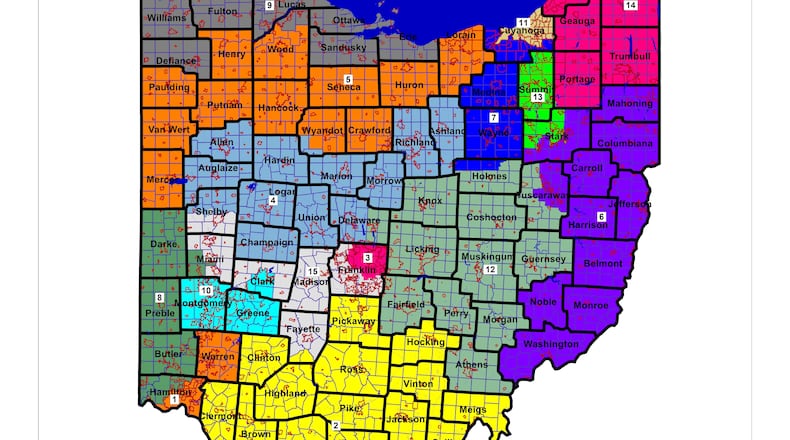The Ohio Supreme Court has thrown out two U.S. House maps, and two sets of Ohio House and Senate district maps, as unfairly favoring Republicans. The Republican Party dominates the General Assembly and also holds five of the seven seats on the redistricting commission.
A court ruling on a third set of state House and Senate maps is still pending; pressure on all parties is increasing due to the approach of the May 3 primary election. Candidates have already filed for legislative seats for which there are not yet approved district boundaries.
The redistricting commission on March 2 approved a third version for U.S. House districts. It passed on a 5-2 party-line vote with no Democratic support. The court is now mulling its constitutionality.
In its Monday petition, the League of Women Voters asked the court to order redrawing of two proposed U.S. House districts — both in southwest Ohio.
One is District 15, proposed to cover parts of Clark, Miami, Shelby, Madison, Franklin and Fayette counties. In doing so it dilutes the Democratic suburbs of Columbus with rural Republican voters three counties away, plaintiffs say.
The other is District 1, which the contested map makes what should be a strong Democratic district in Hamilton County “closely competitive” by pairing much of Hamilton with heavily Republican Warren County.
“Correcting these two districts will go a long way toward bringing the congressional map into constitutional compliance,” the motion says. “This court need not itself enact a map. This remedy is not complicated. It can be achieved swiftly — and is long overdue.”
On Tuesday afternoon, an order from Chief Justice Maureen O’Connor told the redistricting commission to reply by noon Thursday, with no time extensions to be granted.
Three Republican members of the redistricting commission filed their responses Tuesday to a similar enforcement order in a companion case.
A filing on behalf of Secretary of State Frank LaRose says the latest U.S. House map should stand, and that the court cannot impose a map of its own.
Moving the primary to a later date has been suggested, but only the General Assembly can do that, his filing says.
A joint filing for Senate President Matt Huffman, R-Lima, and House Speaker Bob Cupp, R-Lima, asks the court to allow the latest map to be used at least for this election, and hold any further action until after the 2022 election cycle.
For that matter, the filing says, the court itself ruled Dec. 3 that the redistricting commission — as an entity — was no longer a party to the case, so the court cannot order it to enact a new plan.
If that’s what plaintiffs want, they should file a new lawsuit and start all over, the filing says.
The document for Huffman and Cupp reiterates an argument Huffman made at the commission: In this round of map-drawing, requirements for fairness that applied to the “general assembly” don’t apply to maps the commission draws.
In accordance with 2020 census results, Ohio must reduce its U.S. House seats from 16 to 15. Currently Ohio is represented by 12 Republicans and four Democrats.
In November legislators passed a new U.S. House map, but voting-rights and progressive groups filed suit. The Ohio Supreme Court threw out that map on Jan. 14 and told the General Assembly to try again. The General Assembly took no action, however, sending the job back to the Ohio Redistricting Commission.
The latest congressional plan would ostensibly create 10 Republican-leaning and five Democratic-leaning seats. But three of the Democratic-leaning seats only do so by less than 5%, while none of the Republican-leaning districts do so by less than 6.64%, according to the breakdown mapmakers distributed.
About the Author

